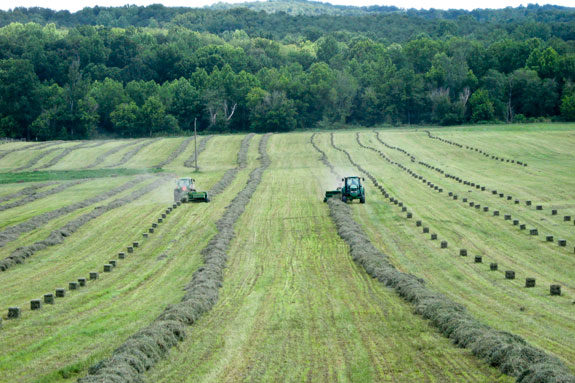As we explained last month, deciding when to take your first cut is an important decision as the timing of the first cut can affect not only forage quality, but also the total tonnage produced for the season.
But timing affects every aspect of alfalfa production. Cut timing and interval play a pivotal role in the quality and tonnage you’ll get from each field. Timing impacts neutral detergent fiber (NDF) levels, moisture content and leaf retention.
Alfalfa fed to lactating cows normally should be harvested at 40 percent NDF. Diets formulated with high NDF forages must include a higher concentration of grain to increase energy density and reduce the filling effect of the diet. Protein content of these forages is also lower so more protein supplementation is necessary.
The 40 percent NDF goal is thought to optimize profitability from the combination of alfalfa yield, ration supplement cost and overall herd milk production. With warm weather, NDF can increase about 0.7 units per day, so quality can drop rapidly. Of course, finding a window of dry weather can complicate things even further.
The moisture of a standing alfalfa crop in late bud to early flowering, which is the ideal cutting time for dairy quality hay or haylage, is generally 75 to 80 percent. Ideally, this should dry down to 55 to 65 percent moisture depending on type of storage structure, which takes about 24 hours under normal conditions.
If the forage is too dry, the leaves can separate from the stems and be lost. This is a critical concern as the leaves are the most nutrient-rich part of the plant. Alfalfa stems contain about 11 percent crude protein, while alfalfa leaves contain more than 24 percent crude protein.
When to begin cutting is always a difficult decision. Methods used to determine when to cut include the calendar date, stage of development, growing degree days (GDD), scissors cut data, and Predictive Equations for Alfalfa Quality (PEAQ).Though no method will predict the NDF content perfectly, the predictive models reduce the guess work.
A few important tips to remember when using each method include:
- Maturity by calendar date can vary widely from year to year.
- Average stage of development can be difficult to determine across a field, particularly if there is insect damage.
- If using the GDD method, be sure to use the correct equation for alfalfa.
- Do not use the GDD method when there is inadequate soil moisture during the growing season. GDD accumulate with little to no response in plant growth. The GDD method is most accurate for first spring harvest.
- If using the scissor cut method, be sure to take multiple samples throughout the field and cool your samples after cutting, but do not freeze them. Freezing will increase NDF content.
- When using the PEAQ method, be sure to get a sampling from various parts of the field.
- The PEAQ method is most accurate for first and second cutting.
- The GDD or PEAQ methods are not very accurate in fields containing grass.
To improve forage quality in delayed harvest situations, consider using a high-quality inoculant.
Photo courtesy of Clayton Geralds










